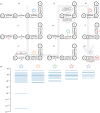Ion channel model reduction using manifold boundaries
- PMID: 35946166
- PMCID: PMC9363999
- DOI: 10.1098/rsif.2022.0193
Ion channel model reduction using manifold boundaries
Abstract
Mathematical models of voltage-gated ion channels are used in basic research, industrial and clinical settings. These models range in complexity, but typically contain numerous variables representing the proportion of channels in a given state, and parameters describing the voltage-dependent rates of transition between states. An open problem is selecting the appropriate degree of complexity and structure for an ion channel model given data availability. Here, we simplify a model of the cardiac human Ether-à-go-go related gene (hERG) potassium ion channel, which carries cardiac IKr, using the manifold boundary approximation method (MBAM). The MBAM approximates high-dimensional model-output manifolds by reduced models describing their boundaries, resulting in models with fewer parameters (and often variables). We produced a series of models of reducing complexity starting from an established five-state hERG model with 15 parameters. Models with up to three fewer states and eight fewer parameters were shown to retain much of the predictive capability of the full model and were validated using experimental hERG1a data collected in HEK293 cells at 37°C. The method provides a way to simplify complex models of ion channels that improves parameter identifiability and will aid in future model development.
Keywords: electrophysiology; identifiability; ion channel; mathematical model; model reduction.
Figures




References
-
- Gerach T, Weiß D, Dössel O, Loewe A. 2019. Observation guided systematic reduction of a detailed human ventricular cell model. In 2019 Computing in Cardiology (CinC), pp. 1–4. Singapore: IEEE.
Publication types
MeSH terms
Substances
Grants and funding
LinkOut - more resources
Full Text Sources

